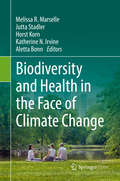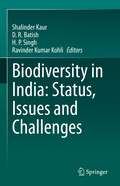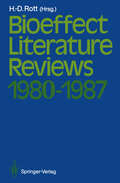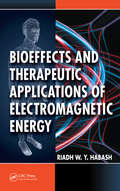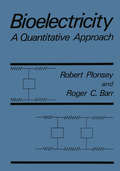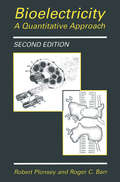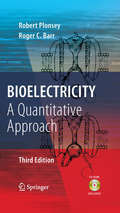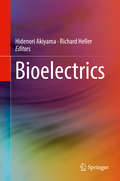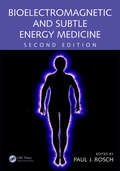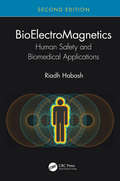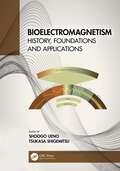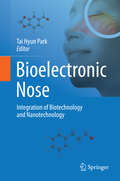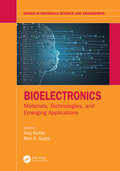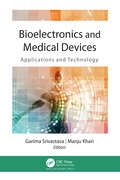- Table View
- List View
Biodiversity and Health in the Face of Climate Change
by Melissa R. Marselle Jutta Stadler Horst Korn Katherine N. Irvine Aletta BonnThis open access book identifies and discusses biodiversity’s contribution to physical, mental and spiritual health and wellbeing. Furthermore, the book identifies the implications of this relationship for nature conservation, public health, landscape architecture and urban planning – and considers the opportunities of nature-based solutions for climate change adaptation. This transdisciplinary book will attract a wide audience interested in biodiversity, ecology, resource management, public health, psychology, urban planning, and landscape architecture. The emphasis is on multiple human health benefits from biodiversity - in particular with respect to the increasing challenge of climate change. This makes the book unique to other books that focus either on biodiversity and physical health or natural environments and mental wellbeing. The book is written as a definitive ‘go-to’ book for those who are new to the field of biodiversity and health.
Biodiversity in India: Status, Issues and Challenges
by Shalinder Kaur D. R. Batish H. P. Singh Ravinder Kumar KohliThis contributed book is based on the current status of biodiversity in India, issues and challenges faced by the authorities involved in conservation efforts, and the imperative role of various direct and indirect stakeholders in biodiversity conservation. The book discusses the current status of different forms of biodiversity in India, challenges faced by stakeholders, issues and reasons for biodiversity losses, and efforts by government through various laws, policies, and programs in a concise and comprehensive manner throughout its many chapters. In this way, readers can access diverse information on Indian biodiversity through this book. It is compiled by leading experts in the field of conservation. In 18 chapters, it covers biodiversity of both fauna and flora, on land and in aquatic ecosystems, legal and policy aspects, as well as innovative conservation tool and techniques. It is useful for undergraduates and graduate students and also educates policy planners, bureaucrats, foresters, and researchers in India and abroad.
Biodiversity of Southeast Asian Parasites and Vectors causing Human Disease (Parasitology Research Monographs #14)
by Trevor N. Petney Weerachai Saijuntha Heinz MehlhornThis thematic collection focuses on key parasites and their vectors in Southeast Asia. Up-to-date essays invite readers to discover parasite and vector morphology, genetic diversity as well as dynamic parasite communities linked to human land-use and climate change. The authors shed light on transmission pathways and explore tick-borne diseases, intestinal protozoa, cestodes, nematodes and the multiplicity of cryptic trematode species. Particular attention is given to mosquito vectors in changing environments and the dynamic biodiversity of vertebrate hosts, including mammals, birds and fish.The richly illustrated chapters are completed by new approaches in diagnostic methods, treatment and prevention to protect humans and animals from tropical parasite infections. Not only parasitologists and experts in tropical medicine but also public health officials and travelers will find this volume highly informative.
Biodrug Delivery Systems: Fundamentals, Applications and Clinical Development
by Kinam Park Mariko MorishitaBiodrug Delivery Systems: Fundamentals, Applications and Clinical Development presents the work of an international group of leading experts in drug development and biopharmaceutical science who discuss the latest advances in biodrug delivery systems and associated techniques. The book discusses components of successful formulation, delivery, and p
Biodynamic Excisional Skin Tension Lines for Cutaneous Surgery
by Sharad P. PaulThis book is a detailed review of the ‘state-of-the art’ of skin lines in cutaneous surgery. Surgical literature is inundated with references to Langer’s Lines, Cleavage Lines, Wrinkle Lines and Relaxed Skin Tension Lines, but this title discusses the difference between these and incisional and excisional lines biomechanically, introducing the concept of biodynamic excisional skin tension (BEST) Lines.The problem with current concepts of skin tension lines is that they seem to differ in different textbooks, and lines for surgical egress, which work in conditions of low tension, are not necessarily suitable for skin cancer surgery. Biodynamic Excisional Skin Tension Lines for Cutaneous Surgery describes skin biomechanics, the properties of collagen and elastin, lower limb skin vascularity and also maps BEST lines across the body, making it a great reference guide for plastic or dermatologic surgery worldwide. As such, it will be beneficial for anyone performing cutaneous surgery and skin cancer excisions in clinical practice, or for those planning further research into skin biomechanics to read this volume.
Biodynamics: Circulation
by Y. C. FungThis book is a continuation ofmy Biomechanics.The first volume deals with the mechanical properties of living tissues. The present volume deals with the mechanics ofcirculation. A third volume willdeal with respiration, fluid balance, locomotion, growth, and strength. This volume is called Bio dynamics in order to distinguish it from the first volume. The same style is followed. My objective is to present the mechanical aspects ofphysiology in precise terms ofmechanics so that the subject can become as lucid as physics. The motivation of writing this series of books is, as I have said in the preface to the first volume, to bring biomechanics to students ofbioengineer ing, physiology, medicine, and mechanics. I have long felt a need for a set of books that willinform the students ofthe physiological and medical applica tions ofbiomechanics,and at the same time develop their training in mechan ics. In writing these books I have assumed that the reader already has some basic training in mechanics, to a level about equivalent to the first seven chapters of my First Course in Continuum Mechanics (Prentice Hall, 1977). The subject is then presented from the point of view of life science while mechanics is developed through a sequence of problems and examples. The main text reads like physiology, while the exercises are planned like a mechanics textbook.The instructor may filla dual role :teaching an essential branch of life science, and gradually developing the student's knowledge in mechanics.
Bioeffect: Literature Reviews 1980–1987
by Hans-DieterRottDiagnostic ultrasound has been in clinical use for more than 25 years, during which time it has been introduced into nearly all clinical disciplines. No substantial arguments for any adverse ef fects have been found. It is therefore commonly accepted that sono graphy is safe and causes no health risks. However, safety is not a property that can be proved experimentally; rather, it is character ized by the absence of detectable adverse effects in various relevant investigations. It is reasonable always to reconsider this assumption of safety by evaluating the latest results of ultrasound bioeffect re search. Thus the European Federation of Societies for Ultrasound in Medicine and Biology (EFSUMB) decided to establish a bio effect group with the task of - assessing existing documentation on the subject - carrying out a continuing review of the literature, particularly in relation to any new evidence that might modify existing conclu sions and recommendations - making reports to the membership on the state of the subject at such times and in such ways as seems appropriate The Watchdog Group was instituted in 1979 and named the Euro pean Committee for Ultrasonic Radiation Safety. It comprises ex perts in the field on an interdisciplinary basis, including physicists, biologists, gynecologists, and a geneticist. Since its formation the Watchdog Group has met once a year to discuss relevant topics. Its activities include the composition of reports, statements, and publi cations, as well as the organization of panel discussions.
Bioeffects and Therapeutic Applications of Electromagnetic Energy
by Riadh HabashFrom cell phones to treating cancer, EM energy plays a part in many of the innovations that we take for granted everyday. A basic force of nature, like nuclear energy or gravity, this energy can be harnessed and used, but still holds the potential to be harmful. The question remains, how safe are EM products? Bioeffects and Therapeutic Applicati
Bioelectricity: A Quantitative Approach
by Roger C. Barr Robert PlonseyThis text is an introduction to electrophysiology, following a quantitative approach. The first chapter summarizes much of the mathematics required in the following chapters. The second chapter presents a very concise overview of the general principles of electrical fields and current flow, mostly es tablished in physical science and engineering, but also applicable to biolog ical environments. The following five chapters are the core material of this text. They include descriptions of how voltages come to exist across membranes and how these are described using the Nernst and Goldman equations (Chapter 3), an examination of the time course of changes in membrane voltages that produce action potentials (Chapter 4), propagation of action potentials down fibers (Chapter 5), the response of fibers to artificial stimuli such as those used in pacemakers (Chapter 6), and the voltages and currents produced by these active processes in the surrounding extracellular space (Chapter 7). The subsequent chapters present more detailed material about the application of these principles to the study of cardiac and neural electrophysiology, and include a chapter on recent developments in mem brane biophysics. The study of electrophysiology has progressed rapidly because of the precise, delicate, and ingenious experimental studies of many investigators. The field has also made great strides by unifying the numerous experimental observations through the development of increasingly accurate theoretical concepts and mathematical descriptions. The application of these funda mental principles has in turn formed a basis for the solution of many different electrophysiological problems.
Bioelectricity: A Quantitative Approach
by Robert Plonsey Roger C. BarrIn the first edition of Bioelectricity, Plonsey and Barr provided an introduction to electrophysiology following a quantitative approach. In this second edition they address new discoveries in the field of ion channels. The text is an introduction to electrophysiology utilizing a quantitative approach. It describes the principles of electrical fields, using basic principles from science and engineering while taking the biological applications into consideration. The book thus provides an introduction to the quantitative description of underlying electrophysiology with illustrative application to cardiac electrophysiology and functional electrical stimulation. The book can be used as a bridge to more advanced texts, particularly those that stress a quantitative approach.
Bioelectricity: A Quantitative Approach
by Robert Plonsey Roger C. BarrThis is the new edition of the classic introductory text to electrophysiology. It covers many topics that are central to the field including the electrical properties of the cell membrane and cardiac electrophysiology. Organized as a textbook for the student needing to acquire the core competencies, this book meets the demands of advanced undergraduate or graduate coursework in biomedical engineering and biophysics. New features include extra, detailed illustrations. The book is authored by two eminent biomedical engineering professors at Duke University who discuss many topics that are central to biophysics and bioengineering and the quantitative methods employed.
Bioelectrics
by Hidenori Akiyama Richard HellerThis book focuses on bioelectrics, a new multidisciplinary field encompassing engineering and biology with applications to the medical, environmental, food, energy, and biotechnological fields. At present, 15 universities and institutes in Japan, the USA and the EU comprise the International Consortium of Bioelectrics, intended to advance this novel and important research field. This book will serve as an introductory resource for young scientists and also as a textbook for use by both undergraduate and graduate students – the world’s first such work solely devoted to bioelectrics.
Bioelectrochemical Systems: Vol.1 Principles and Processes
by Prasun Kumar Chandrasekhar KuppamThis book is the first in a two-volume set devoted to bioelectrochemical systems (BESs) and the opportunities that they may offer in providing a green solution to growing energy demands worldwide. In this first volume, established research professionals explain the underlying principles and processes of BESs, providing a thorough introduction to these systems before proceeding to address the roles of cathode catalysts and biocatalysts, biofilms, heterotrophic denitrification, and nanotechnology approaches. This volume forms a sound foundation for understanding the potential industrial applications of this technology, which include in particular the generation of high-value chemicals and energy using organic wastes. These applications are the focus of the second volume, where readers will find up-to-date information on microbial fuel cells and the use of microbial biofilm- and algae-based bioelectrochemical systems for bioremediation and co-generation of valuable chemicals. The book is designed for a broad audience, including undergraduates, postgraduates, energy researchers/scientists, policymakers, and anyone else interested in the latest developments in this field.
Bioelectrochemical Systems: Vol.2 Current and Emerging Applications
by Prasun Kumar Chandrasekhar KuppamThis book is the second in a two-volume set devoted to bioelectrochemical systems (BESs) and the opportunities that they may offer in providing a green solution to growing energy demands worldwide. While the first volume explains principles and processes, in this volume established research professionals shed light on how this technology can be used to generate high-value chemicals and energy using organic wastes. Bioelectricity is generated in microbial fuel cells (MFCs) under oxygen-depleted conditions, where microbial bioconversion reactions transform organic wastes into electrons. Dedicated chapters focus on MFCs and state of the art advancements as well as current limitations. In addition, the book covers the use of microbial biofilm- and algae-based bioelectrochemical systems for bioremediation and co-generation of valuable chemicals. A thorough review of the performance of this technology and its possible industrial applications is presented. The book is designed for a broad audience, including undergraduates, postgraduates, energy researchers/scientists, policymakers, and anyone else interested in the latest developments in this field.
Bioelectromagnetic and Subtle Energy Medicine
by Davis LangdonBioelectromagnetic and Subtle Energy Medicine focuses on a wide variety of evidence-based bioelectromagnetic and subtle energy therapies for disorders ranging from cancer, cardiomyopathy, and Parkinson's disease to depression, anxiety, and pain. Since publication of the first edition more than a decade ago, there have been so many advances in these
BioElectroMagnetics: Human Safety and Biomedical Applications
by Riadh HabashThis book is an educational resource of evolving scientific knowledge in the area of bioelectromagnetics that may serve the interests of students and decision-makers, as well as society as a whole. It is distinguished by extensive descriptions of fundamental biophysical concepts and their relevance to human health. Reflecting the transdisciplinary approach from several different intellectual streams including physics, biology, epidemiology, medicine, environment, risk science, and engineering, the book is quite a venture into the battling studies to assess the latest research on health effects and biomedical applications of EM energy. This new edition of the book particularly looks at the potential threats from the emerging 5G wireless networks, which will deploy large numbers of low-powered smartphones, notebooks, tablets, radio access networks, and other transmitters. Features Introduces necessary biophysical principles of EM fields in the context of their interaction with living systems. Strengthens understanding of cutting-edge research on several major areas in the broad area of bioelectromagnetics. Presents safety standards and guidelines for human exposure to EM fields. Discusses techniques that have been developed to ensure adequate EM-thermal dosimetry required for both health effects and biomedical applications. Provides insight into the determinants of EM health risk assessment and public concerns. Includes extensive reference list at the end of each chapter to enhance further study. Riadh Habash is a special appointment professor and McLaughlin Research Chair in Electromagnetic Fields and Health at the University of Ottawa, Canada. He has been the recipient of many awards, including the National Wighton Fellowship Award, and has authored or co-authored over 90 research articles, six books, and five book chapters. His most recent books are Green Engineering in 2017 and Professional Practice in 2019 (CRC Press), with the remaining previous books targeting the area of bioelectromagnetics.
BioElectroMagnetics: Human Safety and Biomedical Applications
by Riadh HabashThis book is an educational resource of evolving scientific knowledge in the area of bioelectromagnetics that may serve the interests of students and decision-makers, as well as society as a whole. It is distinguished by extensive descriptions of fundamental biophysical concepts and their relevance to human health. Reflecting the transdisciplinary approach from several different intellectual streams including physics, biology, epidemiology, medicine, environment, risk science, and engineering, the book is quite a venture into the battling studies to assess the latest research on health effects and biomedical applications of EM energy. This new edition of the book particularly looks at the potential threats from the emerging 5G wireless networks, which will deploy large numbers of low-powered smartphones, notebooks, tablets, radio access networks, and other transmitters. Features Introduces necessary biophysical principles of EM fields in the context of their interaction with living systems. Strengthens understanding of cutting-edge research on several major areas in the broad area of bioelectromagnetics. Presents safety standards and guidelines for human exposure to EM fields. Discusses techniques that have been developed to ensure adequate EM-thermal dosimetry required for both health effects and biomedical applications. Provides insight into the determinants of EM health risk assessment and public concerns. Includes extensive reference list at the end of each chapter to enhance further study. Riadh Habash is a special appointment professor and McLaughlin Research Chair in Electromagnetic Fields and Health at the University of Ottawa, Canada. He has been the recipient of many awards, including the National Wighton Fellowship Award, and has authored or co-authored over 90 research articles, six books, and five book chapters. His most recent books are Green Engineering in 2017 and Professional Practice in 2019 (CRC Press), with the remaining previous books targeting the area of bioelectromagnetics.
Bioelectromagnetics Current Concepts: The Mechanisms of the Biological Effect of Extremely High Power Pulses (Nato Security through Science Series B:)
by Sinerik N. Ayrapetyan Marko S. MarkovThis volume includes the lectures and selected posters on different aspects of biological effects of EMF, presented at the NATO ADVANCED RESEARCH WORKSHOP “The mechanisms of biological effect Extremely High Power Pulses (EHPP)” (3-5 March 2005) and the UNESCO/WHO/IUPAB Seminar “Molecular and Cellular Mechanisms of Biological Effects of EMF” (1-2 March 2005) that took place in Yerevan, Armenia. The gracious support of several international organizations made possible to bring together 47 scientists, engineers, physicians and policy makers from 21 countries from Europe, North and South America, Asia. The Capital of Armenia, Yerevan, provided an excellent opportunity for discussions of the experimental data and theoretical models of EMF effect on various levels, starting from cell aqua bathing medium to the whole organism, including the human, applying multidisciplinary approaches. The continuous increase of the number of man made EMF sources leads to dramatic changes in the spectrum of EMF in the biosphere. During the last two decades the public concern about potential hazard of EMF generated by power and distribution lines, as well as mobile communications and base stations have initiated serious public concern and has triggered the attention of the WHO, which reflected in the EMF project of harmonization of standards. At the same time, contemporary medicine largely uses EMF diagnostic methods. The beneficial effects of EMF are complemented with a large scale of EMF therapeutic modalities used in a number of countries, helping millions of people.
Bioelectromagnetism: History, Foundations and Applications
by Shoogo UenoBioelectromagnetism has been gradually developing and expanding into a variety of fields in engineering, biomedical engineering, life science, medicine and biology. Bioelectromagnetism: History, Foundations and Applications provides an overview of the field and its developments; from its inception and growth through the twenty-first century, to the latest advances in electro- and magnetobiology and hazard evaluations of electromagnetic fields.It is organized into three sections, each focusing on specific regions of bioelectromagnetism. It begins with the foundations of the field and its history, with a chronological treatment of the major subjects in bioelectromagnetism. The relationship between atmospheric electromagnetic phenomena, geomagnetism and biological systems are presented. It then discusses the many benefits of bioelectromagnetism: electroreception, magnetic navigation, magnetic sense and magnetic responses of plants, birds, animals and humans. It then moves on to human health issues and the impact of bioelectromagnetism. It also provides practical guidance on how to set safety guidelines. Finally, it looks forward to the future prospects of the field based on the latest research in the field.In exploring both the history of the field and the latest developments in today’s research advances, this book provides a comprehensive and self-contained treatment on the subject, which will be a valuable reference for researchers in biophysics, medicine, electrical engineering and biomedical engineering.It can be used as a companion to the editor’s previously published books: Biomagnetics: Principles and Applications of Biomagnetic Stimulation and Imaging (9781482239201, 2016, CRC Press); and Bioimaging: Imaging by Light and Electromagnetics in Medicine and Biology (9780367203047, 2020, CRC Press).Key Features: Provides both a historical view of the field, along with the latest developments in the field Contains practical guidance for researchers on how to set safety guidelines for those working in the area Edited by authorities in the field, with chapter contributions from specialists
Bioelectromagnetism: History, Foundations and Applications
by Shoogo Ueno Tsukasa ShigemitsuBioelectromagnetism has been gradually developing and expanding into a variety of fields in engineering, biomedical engineering, life science, medicine and biology. Bioelectromagnetism: History, Foundations and Applications provides an overview of the field and its developments; from its inception and growth through the twenty-first century, to the latest advances in electro- and magnetobiology and hazard evaluations of electromagnetic fields.It is organized into three sections, each focusing on specific regions of bioelectromagnetism. It begins with the foundations of the field and its history, with a chronological treatment of the major subjects in bioelectromagnetism. The relationship between atmospheric electromagnetic phenomena, geomagnetism and biological systems are presented. It then discusses the many benefits of bioelectromagnetism: electroreception, magnetic navigation, magnetic sense and magnetic responses of plants, birds, animals and humans. It then moves on to human health issues and the impact of bioelectromagnetism. It also provides practical guidance on how to set safety guidelines. Finally, it looks forward to the future prospects of the field based on the latest research in the field.In exploring both the history of the field and the latest developments in today’s research advances, this book provides a comprehensive and self-contained treatment on the subject, which will be a valuable reference for researchers in biophysics, medicine, electrical engineering and biomedical engineering.It can be used as a companion to the editor’s previously published books: Biomagnetics: Principles and Applications of Biomagnetic Stimulation and Imaging (9781482239201, 2016, CRC Press); and Bioimaging: Imaging by Light and Electromagnetics in Medicine and Biology (9780367203047, 2020, CRC Press).Key Features: Provides both a historical view of the field, along with the latest developments in the field Contains practical guidance for researchers on how to set safety guidelines for those working in the area Edited by authorities in the field, with chapter contributions from specialists
Bioelectronic Nose: Integration of Biotechnology and Nanotechnology
by Tai Hyun ParkThe “bioelectronic nose”, the device which has a similar function to the human smell sensing system, can be realized by combining the olfactory cells or receptors with nanotechnology. In the last two decades, much has been learned about the smell sensing mechanism in biological systems. With knowledge about the biological olfactory system and the techniques for the expression of biological receptor proteins, we are able to utilize biological materials and systems to mimic the biological olfactory system. In addition to the advances in biological and biotechnological area, nanotechnology has progressed to a great degree. The bioelectronic nose is a good example of the integration of biotechnology and nanotechnology. This book describes basic biological sciences of the olfactory system, biotechnology for the production of olfactory biological elements, and nanotechnology for the development of various sensing devices. The purpose of this book is to provide the reader with a concept, basic sciences, fundamental technologies, applications, and perspectives of the bioelectronic nose.
Bioelectronics: Materials, Technologies, and Emerging Applications (Series in Materials Science and Engineering)
by Anuj Kumar Ram K. GuptaBioelectronics is emerging as a new area of research where electronics can selectively detect, record, and monitor physiological signals. This is a rapidly expanding area of medical research, that relies heavily on multidisciplinary technology development and cutting-edge research in chemical, biological, engineering, and physical science. This book provides extensive information on the (i) fundamental concepts of bioelectronics, (ii) materials for the developments of bioelectronics such as implantable electronics, self-powered devices, bioelectronic sensors, flexible bioelectronics, etc, and (iii) an overview of the trends and gathering of the latest bioelectronic progress. This book will broaden our knowledge about newer technologies and processes used in bioelectronics.
Bioelectronics: Materials, Technologies, and Emerging Applications (Series in Materials Science and Engineering)
by Anuj Kumar Ram K. GuptaBioelectronics is emerging as a new area of research where electronics can selectively detect, record, and monitor physiological signals. This is a rapidly expanding area of medical research, that relies heavily on multidisciplinary technology development and cutting-edge research in chemical, biological, engineering, and physical science. This book provides extensive information on the (i) fundamental concepts of bioelectronics, (ii) materials for the developments of bioelectronics such as implantable electronics, self-powered devices, bioelectronic sensors, flexible bioelectronics, etc, and (iii) an overview of the trends and gathering of the latest bioelectronic progress. This book will broaden our knowledge about newer technologies and processes used in bioelectronics.
Bioelectronics and Medical Devices: Applications and Technology
by Garima Srivastava, Manju KhariThis new volume provides an abundance of information on new biomedical applications being used today. The book covers a wide range of concepts and technologies, discussing such modern technological methods as the Internet of Things, e-pills, biomedical sensors, support vector machines, wireless devices, image and signal processing in e-health, and machine learning. It also includes a discussion on software implementation for the devices used in biomedical applications. The different types of antennas, including antennas using RF energy harvesting for biomedical applications, are covered as well.
Bioelectronics and Medical Devices: Applications and Technology
by Garima Srivastava Manju KhariThis new volume provides an abundance of information on new biomedical applications being used today. The book covers a wide range of concepts and technologies, discussing such modern technological methods as the Internet of Things, e-pills, biomedical sensors, support vector machines, wireless devices, image and signal processing in e-health, and machine learning. It also includes a discussion on software implementation for the devices used in biomedical applications. The different types of antennas, including antennas using RF energy harvesting for biomedical applications, are covered as well.
